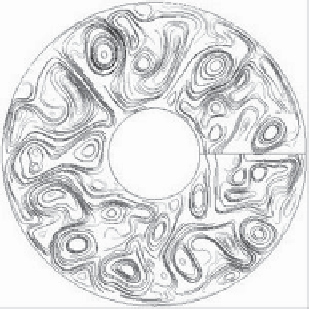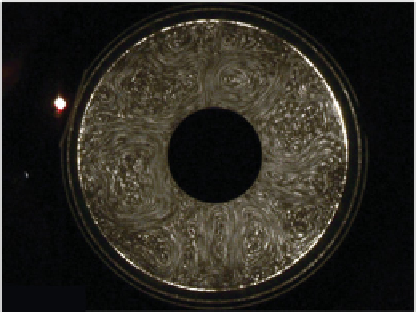Geoscience Reference
In-Depth Information
16/10/06 13:36:29
Experiment
DNS
Figure 16.9.
Comparison between experimental visualization and computed solution for the irregular wave regime in the liquid-
filled cavity, Pr = 16.
water-filled cavity.
Wordsworth et al.
[2008] reported a
detailed analysis of the experimental investigations. The
prohibitive CPU time cost resulting from an adequate
mesh resolution required to resolve all the scales of the
flow did not allow statistical convergence in a reasonable
time. It also points out the actual limitations of computing
power. An extension of the present numerical tool to par-
allel machines is in progress by implementing a domain
decomposition technique, which should allow sufficient
resolution to capture all the turbulence scales.
[
Randriamampianina
, 2013]. Moreover, at low rotation
rate for the later fluid in the weak wave regime, baroclinic
instability was found to develop first near the bottom wall
due to higher density gradient level toward this region
(see Figure 16.5).
We display in Figure 16.10 the instantaneous tem-
perature field at the open upper free surface obtained
from simulation and infrared thermography. As differ-
ent external conditions were used for the simulation
(
T
=2 K,
= 0.8 rad/s) and for the experiment with
T
=8K,
= 0.47 rad/s, the figure is presented to show
qualitative behavior for a three-wave flow between the
two approaches. It appears that the computed result did
not yet reach the asymptotic state, as revealed by the
asymmetry of the waves, in comparison with the mea-
surements.
Harlander et al.
[2012] mentioned from their
experimental investigations that a complete cycle can
take about 27 revolutions. However, an overall agreement
can be observed, in particular a pronounced incursion of
“hot plumes” recirculating from the external hot cylinder
toward the center of the cavity along the anticyclonic
vortices, associated with a strong acceleration as seen
from the superimposed velocity field. Such wave asym-
metry can also be attributed to wave interaction during
the establishment of baroclinic instability, as reported
by
Harlander et al.
[2012].
16.3.3. Open Free-Surface Water-Filled cavity: Pr = 7
Preliminary results are reported for an open upper
free-surface cavity using water as working fluid, Pr= 7,
and compared with available measurements from
K. Alexandrov, Y. Wang, U. Harlander, and C. Egbers
(DFG-MetStroem reference experiment, BTU, Cottbus,
Germany)
. The geometric configuration used in the
simulation is the one considered above in the liquid-filled
cavity, with an inner radius
a
= 4.5 cm, outer radius
b
= 15 cm, and height
d
= 26 cm, while
a
= 4.5 cm,
b
= 12 cm, and
d
=13.5 cm in the experimental setup
[
Harlander et al.
, 2011]. Comparison concerns the tem-
perature distribution at the upper free surface for a
regular wave flow. It is recognized that the occurrence of
baroclinic instability does not depend on the presence or
absence of a top lid [
Hide and Mason
, 1978], even though
significant differences can be observed. The open free
surface, by inducing a shear flow, triggered by the use of
Neumann conditions at this boundary in the numerical
simulation, yields a motion at this top height with the
associated temperature behavior. On the other hand, in
the presence of a rigid lid, a part of the upper region
remains at the same temperature as the outer hot wall,
as was observed in the liquid-filled cavity with Pr = 16
16.4. CONCLUSIONS
Direct numerical simulations based on high-resolution
pseudospectral methods were carried out for the inves-
tigation of the complex flow regimes occurring in a
differentially heated rotating cylindrical annulus, the
baroclinic cavity. The computed solutions have been
compared with available laboratory measurements in
configurations having an insulating top lid or an open free


















